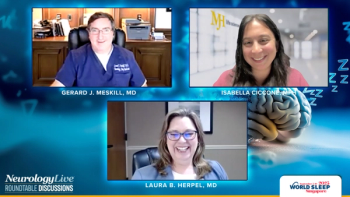
Cytoprotective Therapy Edaravone Dexborneol Improves Poststroke Functional Outcomes
The primary result showed a highly significant effect of edaravone dexborneol on good functional outcome, defined by scores of 0 (no symptoms) or 1 (some symptoms) on the standard modified Rankin scale assessed at 90 days postrandomization.
Recently published data from TASTE-SL, a placebo-controlled, parallel-group, phase 3 trial (NCT04950920), showed that treatment with edaravone dexborneol, a brain cytoprotective agent, can improve the rate of functional outcomes in patients with acute ischemic stroke (AIS) who presented within 48 hours.1
Led by first author Yu Fu, MD, of the department of neurology at Peking University Third Hospital in China, the trial randomly assigned those with AIS to edaravone dexborneol (n = 450) or placebo (edaravone, 0 mg; dexborneol, 60 ug) twice daily for 14 days with follow-up that lasted until 90 days. At the conclusion of the study, good functional outcome, defined as modified Rankin Scale (mRS) scores of 1 or less, were achieved in 64.4% of those on active treatment vs 54.7% of those on placebo (OR, 1.50; 95% CI, 1.15-1.95; P = .003).
Between the 2 groups, safety outcomes were similar. Adverse events (AEs) occurred in 405 patients (89.8%) on edaravone dexborneal vs 418 (90.1%) in the placebo group (OR, 0.99; 95% CI, 0.64-1.53). Treatment-related AEs occurred in 61 patients (13.6%) in the edaravone dexborneol group and in 50 patients (10.8%) in the placebo group (OR, 1.30; 95% CI, 0.87-1.93). Between both the edaravone dexborneal group and placebo group, the most common AE recorded was metabolism and nutrition disorders, occurring in 46.2% and 48.1% of patients, respectively.
The frequency of serious AEs was low and balanced between randomized groups. In a related editorial, stroke expert Craig S. Anderson, MD, PhD, professor of neurology at UNSW Sydney, wrote that this, "a remarkable result, and given that edaravone dexborneol is low cost, simple to administer (even in patients who are unconscious, disabled, or dysphagic), and readily available in China, it has major potential practice implications."2
Anderson, who authored the piece with Lily Song, MD, PhD, a conjoint senior lecturer at UNSW Sydney, went on to commend the investigators of TASTE-SL for "choosing a high-quality study design with broad inclusion criteria and central randomization (with stratification on the prognostic variables of site and time) for double-blind treatment allocation. This promising zone method allowed them to assess futility after half of the patients had been enrolled. In addition, the trial adhered closely to the predefined protocol and analysis plan. Considerable efforts were also devoted to quality-assurance activities, such as training the site investigators and monitoring their adherence to the protocol. However, several inconsistencies in the study outcomes and approaches to analysis and reporting raise concerns."
READ MORE:
TASTE-SL was comprised of patients aged 18 to 80 years old with a National Institutes of Health Stroke Scale score between 6 and 20, a total motor deficit score of the upper and lower limbs of 2 or greater, a clinically diagnosed AIS symptom within 48 hours, and an mRS score of 1 or less before stroke. All patients included were of Chinese Han ethnicity.
For the secondary outcomes, an ordinal comparison of the distribution of patients across mRS categories showed that the good function outcome favored the edaravone dexborneol group (common OR, 1.33; 95% CI, 1.05-1.68). Despite this, edaravone dexborneol had no impact on other prespecified secondary outcomes, which included the proportion of patients with an mRS score of 2 or less, between-group differences in change in NIHSS score from baseline to day 14, and the proportion of NIHSS scores of 1 or less on day 14, 30, and 90. Subgroup analyses that included those with a history of hypertension, stroke, hyperlipidemia, diabetes, heart disease, all confirmed the primary outcome that sublingual edaravone dexborneal outperformed placebo.
Anderson and Song added, "Because maximizing access to reperfusion treatment is at the forefront of modern stroke services, and disease and social reasons for delayed presentation after symptom onset differ across regions, the TASTE-SL results are promising but less relevant to contemporary clinical practice outside of China. However, they provide a clear justification for further evaluations of edaravone dexborneol in other populations, and for individual patient data meta-analysis to be undertaken to determine the totality of the evidence. The performance bar is set high, but the benefits offered by safe treatments with only modest effects in reducing the burden of acute ischemic stroke worldwide are considerable."
REFERENCES
1. Fu Y, Wang A, Tang R, et al. Sublingual edaravone dexborneal for the treatment of acute ischemic stroke: the TASTE-SL randomized clinical trial. JAMA Neurol. Published online February 19, 2024. doi:10.1001/jamaneurol.2023.5716
2. Anderson CS, Song L. Promising efforts to define a novel approach to neuroprotection for acute ischemic stroke. JAMA Neurol. Published online February 19, 2024. doi:10.1001/jamaneurol.2023.5727
Newsletter
Keep your finger on the pulse of neurology—subscribe to NeurologyLive for expert interviews, new data, and breakthrough treatment updates.




































